An Overview Of Our Solution
- Population Impacted:
- Continent: Asia
Organization type
Population impacted
Size of agricultural area
Production quantity
People employed
Describe your solution
Describe your implementation
External connections
What is the environmental or ecological challenge you are targeting with your solution?
Describe the context in which you are operating
The trees that are providing valuable Ayurveda medicines are vanishing from the forests and could be seen only in traditionally protected sacred forests. Fruits of Terminalia bellirica tree , is one such example and proposed solution is contributing to social, ecological and economic benefits is built around these trees. Due to meager income from fruits but high returns from the timber, these trees are often cut. Therefore the challenge faced to save these giant trees of T.bellirica from sacred groves was manifold. These trees are slow growing and plantation cannot be an answer to clear-felling. The ecological challenge was to re establish the value of fruits, value of trees and create incentive mechanism to avoid felling of remaining trees.
How did you impact natural resource use and greenhouse gas emissions?
Language(s)
Social/Community
Water
Food Security/Nutrition
Economic/Sustainable Development
Climate
Sustainability
Since last year we could collect 4 tons of raw fruits of T. bellirica and could sell about 1.5 tons of destoned fruits to Pukka Herbs. Collectors get Rs. 12 / Kg for fresh fruits. They also participate in drying and de stoning activities and get additional employment. More trees are being certified using Fair Wild standards as the demand from Pukka Herbs is increasing. The breakeven of the business will be achieved in an years’ time when we can supply powder of dried certified fruits with higher price. That means it will be sustainable based on market revenue from next year. After the first two years and support for capacity building investment , we are now not dependent on donor support or any govt. subsidy.
Return on investment
Entrant Image

Entrant Banner Image

